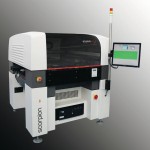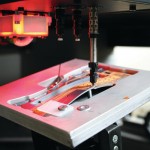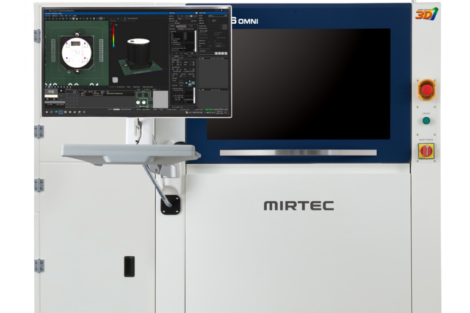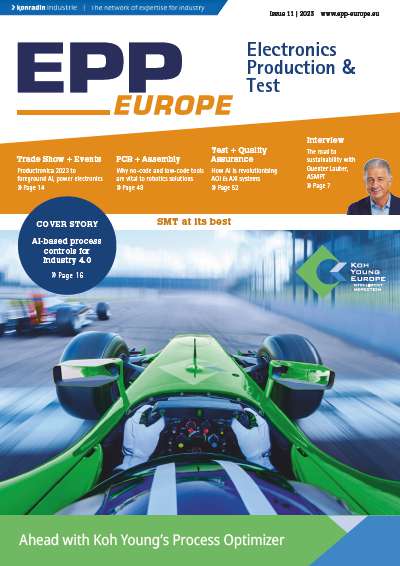Dispensing and MID (Moulded Interconnected Devices) technologies are developing rapidly. Current technology drivers are LED and communication products. On September 28th, Essemtec’s technology day focused on new developments and future challenges. The event was free of charge for all participants.
Essemtec is the leading manufacturer of production systems for electronics. It is the only supplier that can deliver machines, processes and knowhow from one source: dispensers, printers, pick-and-place machines, ovens, storage and handling systems. Every year, the company organizes a technology day at its headquarters in Aesch, Switzerland. Participants from Switzerland, Germany and Austria attend the event, which is free of charge. The aim is to present information about new technologies, processes, machines and applications. This year the main themes were dispensing and 3D-MIDs.
Thixotropy is not shear thinning
The number of applications for jet valves is growing rapidly, especially for LED manufacturing and production. Juergen Staettler, CEO of Vermes Microdispensing GmbH (a subsidiary of the Essemtec Group), knows the reason for this development. Casting LEDs with filled media requires flexibility, accuracy and speed that currently can be achieved only by piezo jet valves. They offers two types of valves that differ in the application of force to the dispense media. High viscosity fluids require the direct high force of the piezo. Typically, these valves are considered open. For low viscosity fluids, closed valves generally are used.
Selecting the right valve, the correct nozzle and the appropriate valve timing is a demanding task. The process engineer must not only know the required cycle time but also must have a lot of information about the medium rheology and the application. Rheology includes many properties such as the viscosity, thread formation, temperature and fillers. The process engineer also strongly distinguishes between shear thinning (no structure rebuilding at rest) and thixotropy (rebuilding of structure at rest). The speed of a jet valve is limited due to self-heating of the piezo. 500 Hz is a high frequency for a piezo jet valve and 1000 Hz can be achieved only for a short period. Reaching the required cycle time requires long-term experience. The company currently is developing a new technology that soon will break the current limitations.
New dispensing machines
Jet valves can be installed on the new Scorpion dispensing machine and the new Paraquda pick-and-place machines from Essemtec. These machines feature an innovative valve quick-change system. Due to the very high speed and accuracy, these machines are well prepared for future applications.
The Scorpion, a pure dispensing machine, is used for all types of dot, line and curve dispensing. Automatic calibration systems for height, viscosity and needle are included. A combined dispensing and placement machine such as the Paraquda is suggested for applications including paste adding, glue dot dispensing for some components or electronics prototyping.
LDS technology for MID
Dirk Baecker from LPKF Laser & Electronics AG informed the group about the interesting development in MID technologies. LDS Laser Direct Structuring, a technology developed by LPKF, is no longer used only for prototypes. There are many new volume products such as antennas for communication devices, automotive and medical applications. The concept is brilliantly simple. A product is made from an LDS polymer or coated with an LDS paint. The laser then roughs (activates) the areas where copper will be built up in a subsequent chemical process. The roughness of the surface ensures excellent adhesion of copper and the work piece. Layout changes only require reprogramming the laser and no tooling costs, making this process very flexible.
3D-MID creates new design rules
Many types of LDS polymers are available for different applications. Even solderable high-temperature thermoplastics exist. It is even possible to create vias in LDS technology. Either the laser burns the required via itself or it activates the surface inside the hole. However, layout designers must become familiar with a couple of new design rules. LDS circuits should be rounded rather than angled so that the laser can activate them with continuous speed. Furthermore, there is a 70° rule: A vertical surface (90°) cannot be activated by the laser. But if a surface is in an angle of 70°, then the laser can selectively activate it without having to turn the work piece.
3D placement and dispensing
MID allows the application of circuits directly to housing parts. Therefore, MIDs are usually in 3-D. In 2011, the organizer introduced Hydra, the first standard machine for the assembly of such products. It is a combination of a Paraquda pick-and-place with a 6 axes robot. Hydra dispenses glue and paste and it places components at almost any angle. Despite the complex process, the machine’s operation is as simple as with a 2D pick-and-place machine. Hydra places all types of SMD components. In 3D mode, the 4-nozzle pick-and-place head can place up to 2,500 components per hour. In 2D mode the placement rate can reach up to 7,000 cph. The machine can be installed in a production line and changeover between products can be very fast. Therefore, Hydra can assemble prototypes as well as series.
The Technology Day 2012 was successful on all levels — from participants who used the visit for a chat with the developers to those who wanted to exchange ideas freely with other electronics manufacturers. And, of course, the day offered an excellent opportunity to get firsthand information about future technologies and challenges.
Share:












